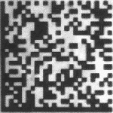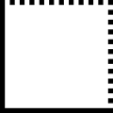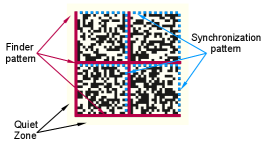Specifications
Reference | Code Snippets


ECC 200, 26x26 cells data matrix code (left) and finder pattern (right)
In a single read operation, EasyMatrixCode2 locates, unscrambles, decodes, reads and grades the quality of grayscale 2D data matrix codes of any size, contrast, location and orientation (even viewed from the back on a transparent medium), providing they meet the following specifications:
|
□
|
Minimum cell (= module) size: 3x3 pixels |
|
□
|
Minimum quiet zone (blank zone around the matrix code) width: 1 pixel |
All the functionalities of EasyMatrixCode2 are available for testing in Open eVision Studio, except for the StopProcess method (for asynchronous processing).
The relevant classes of the EasyMatrixCode2 library are stored in the name space “EasyMatrixCode2”.
Data Matrix Code Definition
|
●
|
A data matrix code is a two-dimensional rectangular array of black and white cells which conveys a string of characters (digits, letters and special characters). |
|
□
|
It is encoded to achieve maximum packing. |
|
□
|
Each cell corresponds to a bit of information. |
|
□
|
Additional redundant bits allow error correction for robust reading of degraded symbols.
|
|
●
|
A data matrix code is located using the Finder pattern: |
|
□
|
The bottom and left edges of a Data Matrix code contain only black cells. |
|
□
|
The top and right edges have alternating cells. |

|
●
|
A data matrix code is characterized by: |
|
□
|
Its encoding type: ECC 000 (odd symbol sizes, deprecated) or ECC 200 (even symbol sizes). |
The data matrix code definition is provided by ISO/IEC and approved as standard ISO/IEC 16022.



